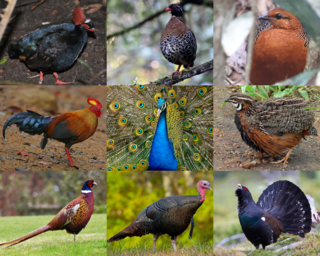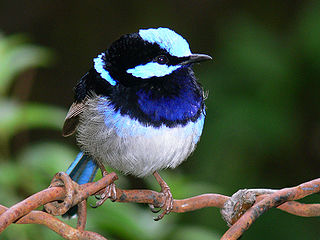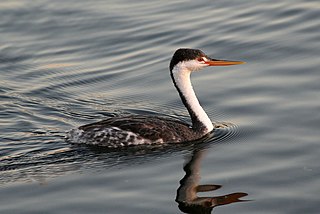
Gaviiformes is an order of aquatic birds containing the loons or divers and their closest extinct relatives. Modern gaviiformes are found in many parts of North America and northern Eurasia, though prehistoric species were more widespread.

Grebes are aquatic diving birds in the order Podicipediformes. Grebes are widely distributed freshwater birds, with some species also found in marine habitats during migration and winter. Some flightless species exist as well, most notably in stable lakes. The order contains a single family, the Podicipedidae, which includes 22 species in six extant genera. Although, superficially, they resemble other diving birds such as loons and coots, they are most closely related to flamingos, as supported by morphological, molecular and paleontological data. Many species are monogamous and are known for their courtship displays, with the pair performing synchronized dances across the water's surface. The birds build floating vegetative nests where they lay several eggs. About a third of the world's grebes are listed at various levels of conservation concerns—the biggest threats including habitat loss, the introduction of invasive predatory fish and human poaching. As such, three species have gone extinct.

The horned grebe or Slavonian grebe is a relatively small waterbird in the family Podicipedidae. There are two known subspecies: P. a. auritus, which breeds in the Palearctic, and P. a. cornutus, which breeds in North America. The Eurasian subspecies is distributed over most of northern Europe and the Palearctic, breeding from Greenland to western China. The North American subspecies spans most of Canada and some of the United States. The species got its name from large patches of yellowish feathers located behind the eyes, called "horns", that the birds can raise and lower at will.
The Sibley–Ahlquist taxonomy is a bird taxonomy proposed by Charles Sibley and Jon E. Ahlquist. It is based on DNA–DNA hybridization studies conducted in the late 1970s and throughout the 1980s.

The Phasianidae are a family of heavy, ground-living birds, which includes pheasants, partridges, junglefowl, chickens, turkeys, Old World quail, and peafowl. The family includes many of the most popular gamebirds. The family is a large one and includes 185 species divided into 54 genera. It was formerly broken up into two subfamilies, the Phasianinae and the Perdicinae. However, this treatment is now known to be paraphyletic and polyphyletic, respectively, and more recent evidence supports breaking it up into two subfamilies: Rollulinae and Phasianinae, with the latter containing multiple tribes within two clades. The New World quail (Odontophoridae) and guineafowl (Numididae) were formerly sometimes included in this family, but are now typically placed in families of their own; conversely, grouse and turkeys, formerly often treated as distinct families, are now known to be deeply nested within Phasianidae, so they are now included in the present family.

The Australasian wrens are a family, Maluridae, of small, insectivorous passerine birds endemic to Australia and New Guinea. While commonly known as wrens, they are unrelated to the true wrens. The family comprises 32 species in six genera.

The pied-billed grebe is a species of the grebe family of water birds. Because the Atitlán grebe has become extinct, the Pied-Billed Grebe is now the sole extant member of the genus Podilymbus. The pied-billed grebe is primarily found in ponds throughout the Americas. Other names of this grebe include American dabchick, rail, dabchick, Carolina grebe, devil-diver, dive-dapper, dipper, hell-diver, pied-billed dabchick, pied-bill, thick-billed grebe, and water witch.

The western grebe is a species in the grebe family of water birds. Folk names include "dabchick", "swan grebe" and "swan-necked grebe".

Clark's grebe is a North American waterbird species in the grebe family. Until the 1980s, it was thought to be a pale morph of the western grebe, which it resembles in size, range, and behavior. Intermediates between the two species are known.

Ovenbirds or furnariids are a large family of small suboscine passerine birds found from Mexico and Central to southern South America. They form the family Furnariidae. This is a large family containing around 315 species and 70 genera. The ovenbird, which breeds in North America, is not a furnariid – rather it is a distantly related bird of the wood warbler family, Parulidae.

The white-eyes are a family, Zosteropidae, of small passerine birds native to tropical, subtropical and temperate Sub-Saharan Africa, southern and eastern Asia, and Australasia. White-eyes inhabit most tropical islands in the Indian Ocean, the western Pacific Ocean, and the Gulf of Guinea. Discounting some widespread members of the genus Zosterops, most species are endemic to single islands or archipelagos. The silvereye, Zosterops lateralis, naturally colonised New Zealand, where it is known as the "wax-eye" or tauhou ("stranger"), from 1855. The silvereye has also been introduced to the Society Islands in French Polynesia, while the Japanese white-eye has been introduced to Hawaii.

The least grebe, an aquatic bird, is the smallest member of the grebe family. It occurs in the New World from the southwestern United States and Mexico to Argentina, and also on Trinidad and Tobago, the Bahamas and the Greater Antilles.

The Titicaca grebe, also known as the Titicaca flightless grebe or short-winged grebe, is a grebe found on the altiplano of Peru and Bolivia. As its name implies, its main population occurs on Lake Titicaca. Lake Uru Uru and Poopó, the Rio Desaguadero, and small lakes that connect to Lake Titicaca in wet years, serve as "spillovers" territory. In the past, the population was larger and several of these lakes – such as Lakes Umayo and Arapa – apparently had and may still have permanent large colonies. It is sometimes placed in Podiceps or a monotypic genus Centropelma. Its local name is zampullín del Titicaca.
Bradley Curtis Livezey was an American ornithologist with scores of publications. His main research included the evolution of flightless birds, the systematics of birds, and the ecology and behaviour of steamer ducks.
Centuriavis is an extinct genus of phasianid landfowl from the Miocene of Nebraska. Known from a well preserved and articulated skeleton preserving the skull as well as much of the vertebral column, its name stems from the fact that it remained undescribed for nearly a hundred years. It is estimated that it weighed 1.7 kg (3.7 lb), which would make it comparable in size with the average female greater sage grouse. Centuriavis may be related to grouse and turkeys and only a single species has been described: Centuriavis lioae.

Thiornis is a fossil genus of Middle Miocene grebe known from a nearly complete specimen from Libros, Spain. Originally classified as a type of moorhen, Thiornis has since been classified as a species of grebe. The overall anatomy of the bird is identical to modern grebes. It contains a single species, T. sociata.

Miobaptus is a fossil genus of grebe that is known from several specimens collected from Czechia and Lake Baikal dating from the Early Miocene to Middle Miocene. Considered to be one of the most primitive genus of grebes, the anatomy of Miobaptus suggests it was less adapted for the aquatic mode of life than modern grebes, but had better flight maneuverablity.

Miodytes is a fossil genus of grebe known from a nearly complete specimen from Valjevo Basin, western Serbia known from an almost complete right wing skeleton. It contains a single species, M. serbicus.

Podicipedini is a tribe of waterbirds belonging to the family Podicipedidae containing the genera Aechmophorus and Podiceps. Members of this tribe of grebes are characterized based on the presence of nuptial plumes and downy young with a bare crown patch. They are more specialized for diving though the anatomy that enables them to do so makes them weaker to stand upright. Further they have much complex mating dance rituals. Based on these characteristics, other possible genera in the clade include Poliocephalus and Rollandia. Indeed a molecular phylogeny by Ogawa et al. (2015) using genetic data from 3 mitochondrial markers found Podiceps to be paraphyletic in respect to Rollandia, as the latter genus is more closely related to several New World species of the former genus. The inclusion of the Neogene genera of Pliolymbus and Thiornis is based on their possible reclassification as junior synonyms as Podiceps.
Podiceps dixi is a possible extinct species of grebe from the United States.


















